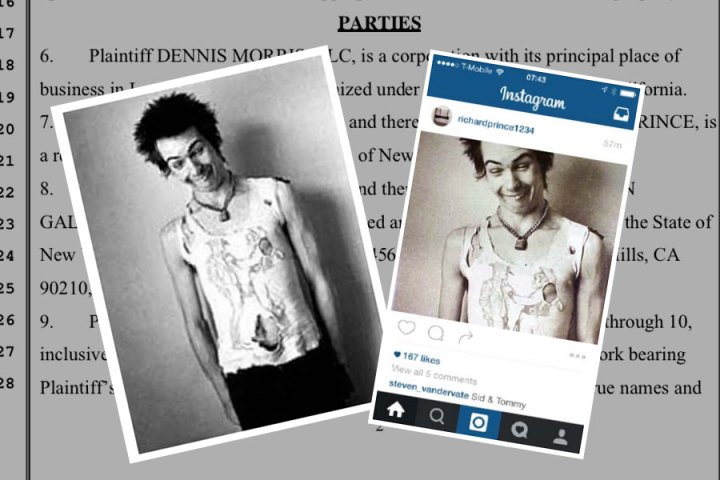
Although perhaps not as recognizable a name as Richard Prince, Morris himself has a storied career history. As a teen, he landed a gig photographing the powerhouse punk band Sex Pistols when they signed with Virgin Records; a gig that turned into a year-long adventure. He had unrestricted access to the band, producing some of their most iconic images, which quickly rocketed Morris to the top bracket of U.K. music photographers.
One of his images, of bassist Sid Vicious, would be published in the biography El Sid, Saint Vicious by David Dalton. A copy of that book, according to the lawsuit, would end up in the hands of none other than Richard Prince, with a dedication by Sex Pistols manager Malcolm McLaren. As described in Bokeh, the portrait has apparently been “rephotographed” by Prince, then cropped and uploaded to his Instagram account. The lawsuit alleges it was also sold as part of an untitled collage piece featuring images of other famous, deceased music artists. (The full lawsuit can be found here.)
In the past, Prince (and the Gagosian gallery where his work is commonly displayed) have been exonerated on the basis of fair use. Art by appropriation is nothing new, but Prince pushes the definition of fair use as if just to test how far it can go. In 2015, he drew attention to himself for leaving comments on photos shared through Instagram, then taking screenshots that included the photo and his comment, and then passing the result off as original work. One such high profile example of this concerned an image by pin-up group Suicide Girls, which Prince enlarged and put on sale for $90,000. Suicide Girls decided not to take legal action, choosing instead to sell their own version of the print for $90 with proceeds going to charity.
Prince’s art exists as a result of the murky understanding of what makes original work. While a more narrowly defined idea of originality and fair use may help photographers in cases like these, it could also potentially harm artists who currently appropriate work in a way that is generally considered acceptable. This is one reason why it’s so difficult to find Prince guilty of copyright infringement, even in cases that may seem obvious.




